12-1 Spinal Nerves AP 150 Chapter 12 12-2

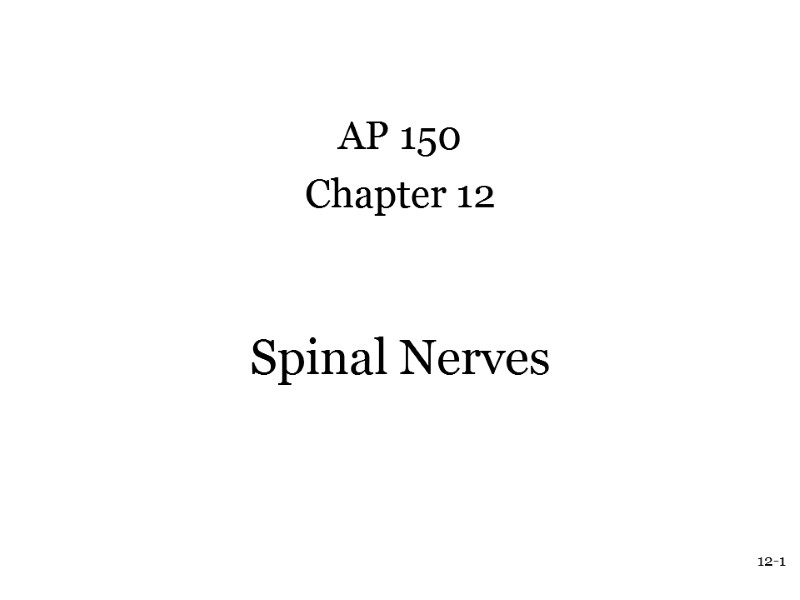
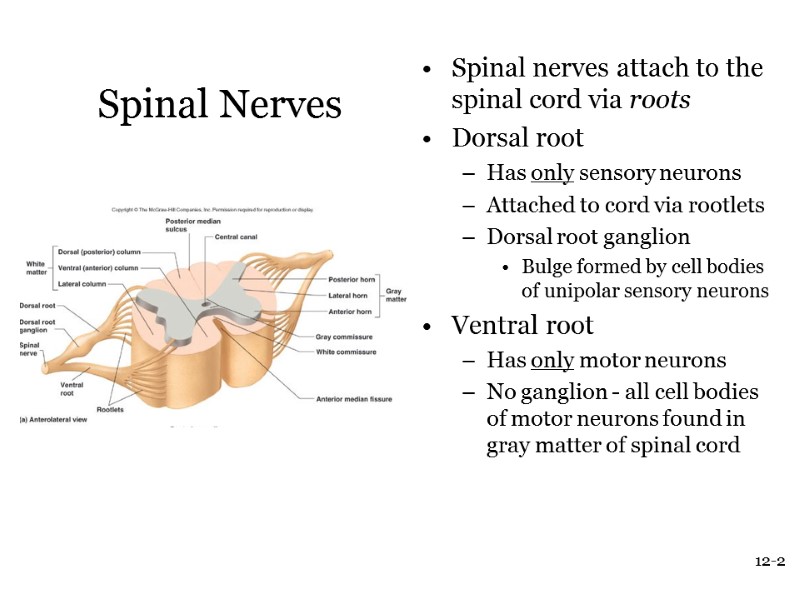
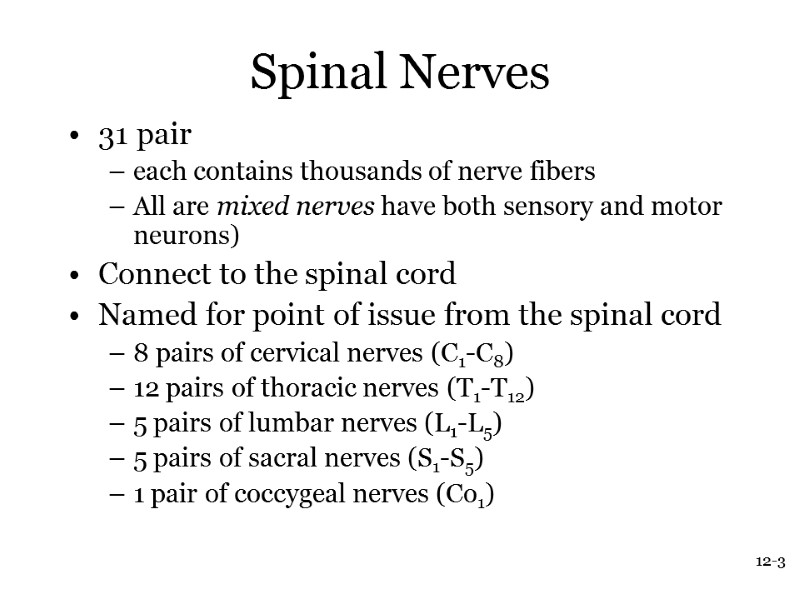
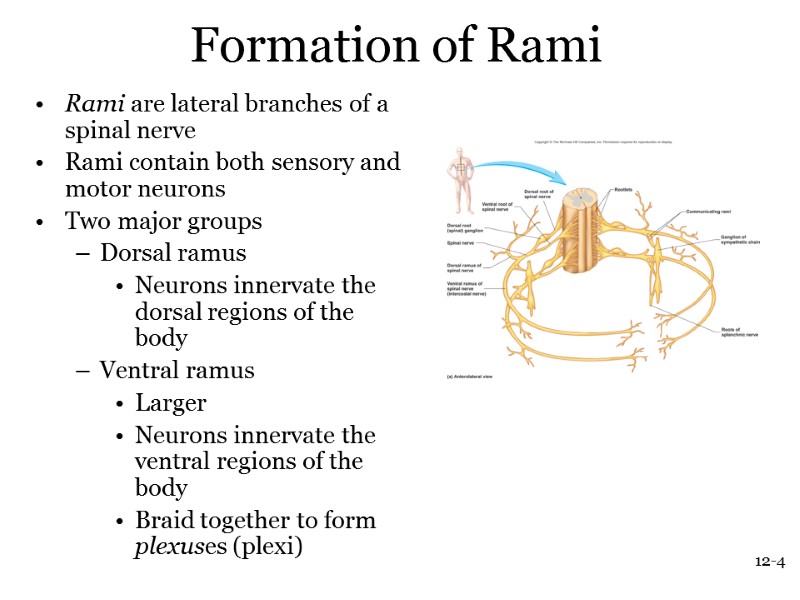
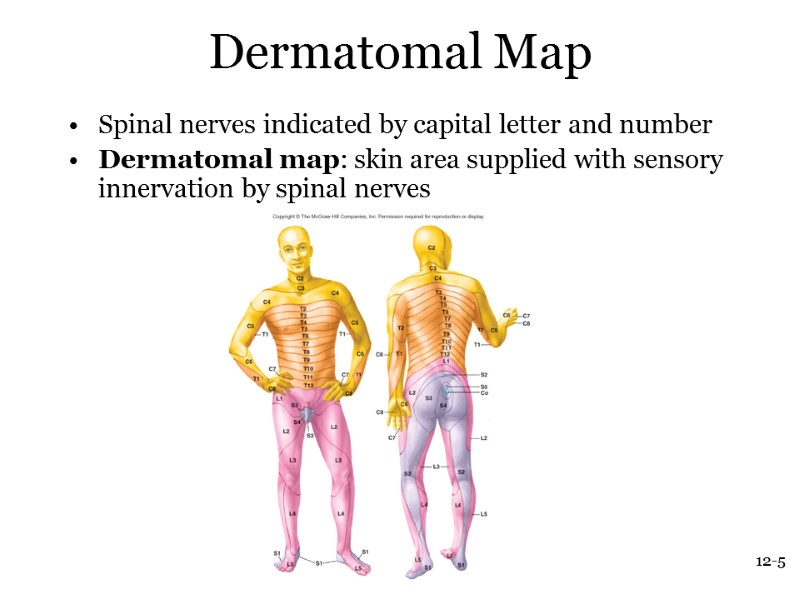
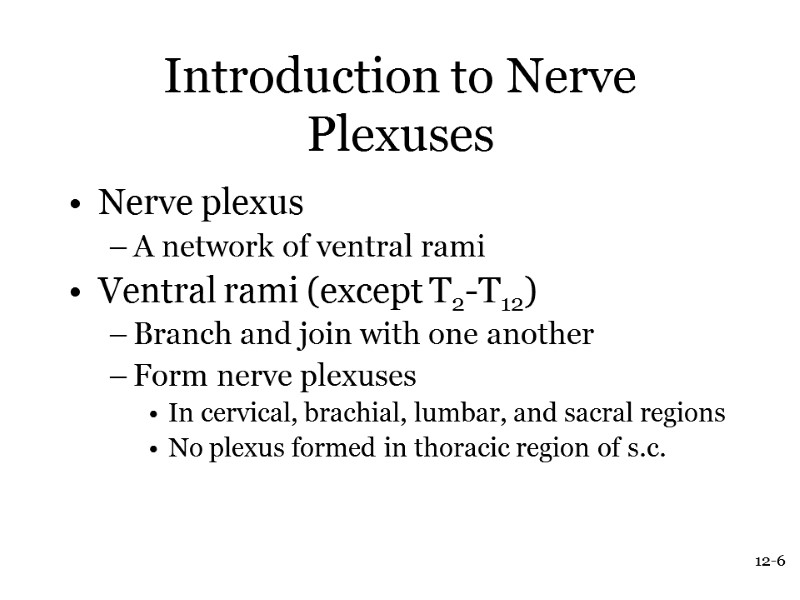
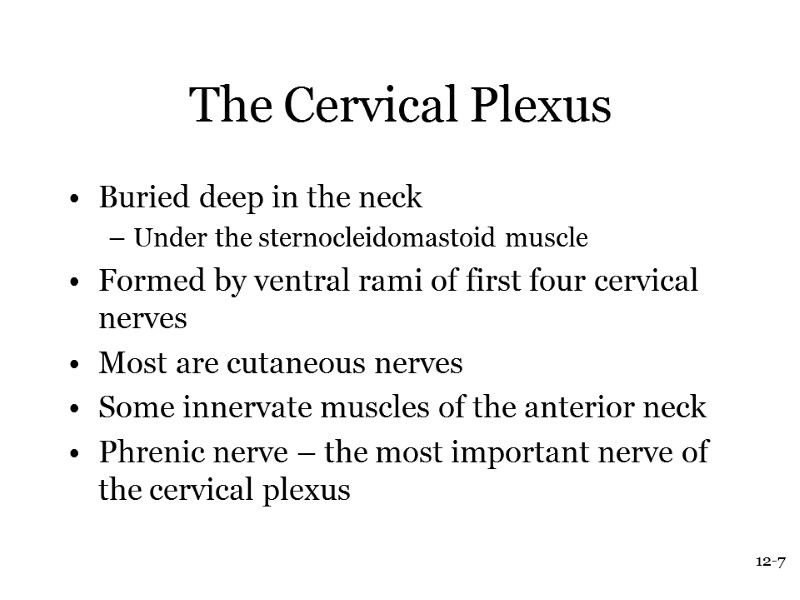
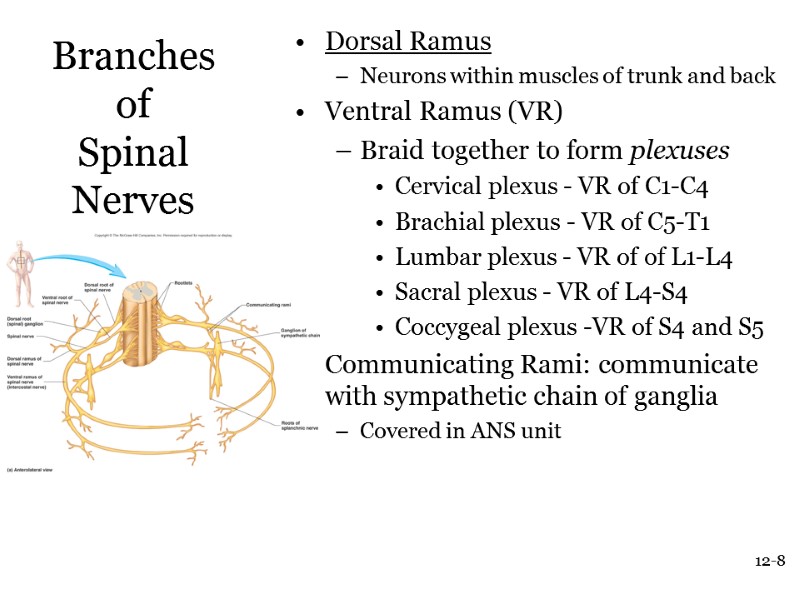
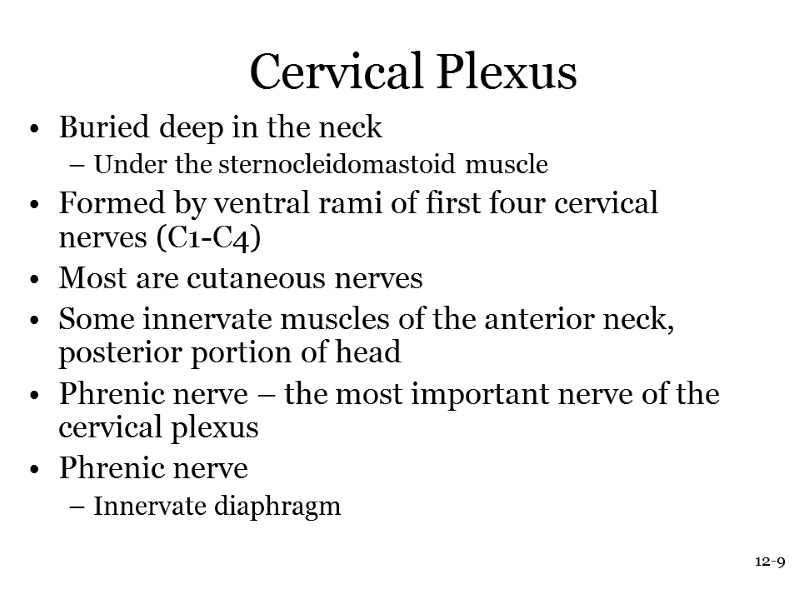
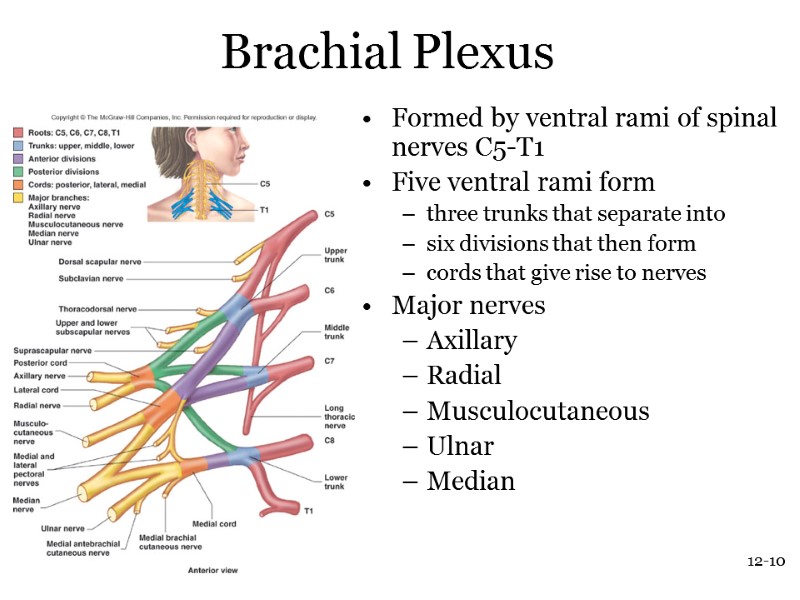
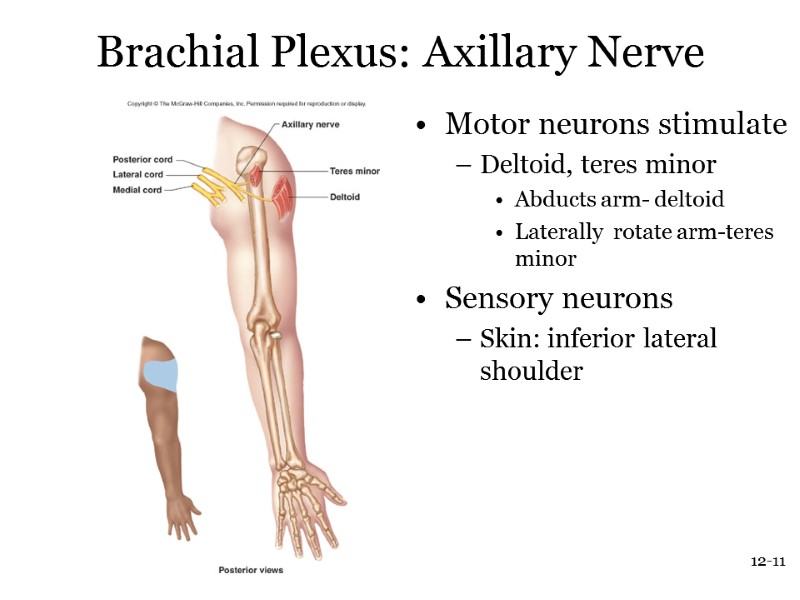
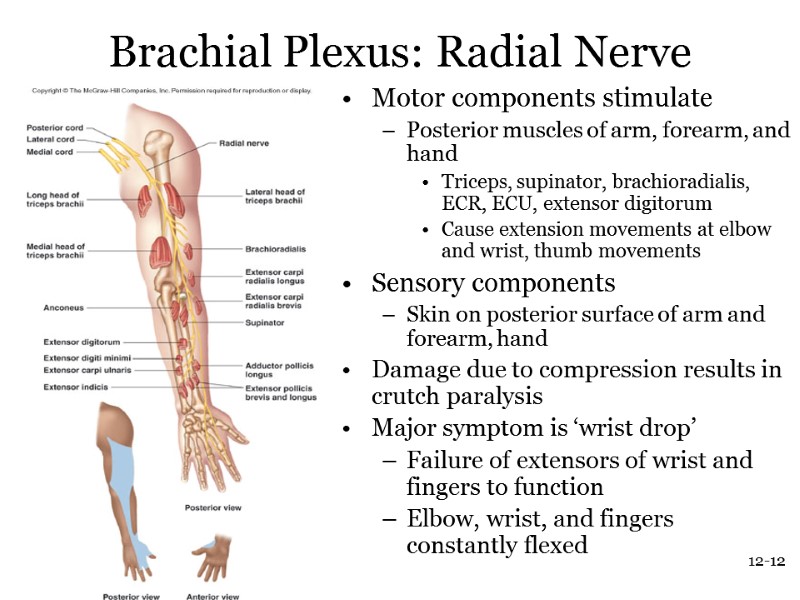
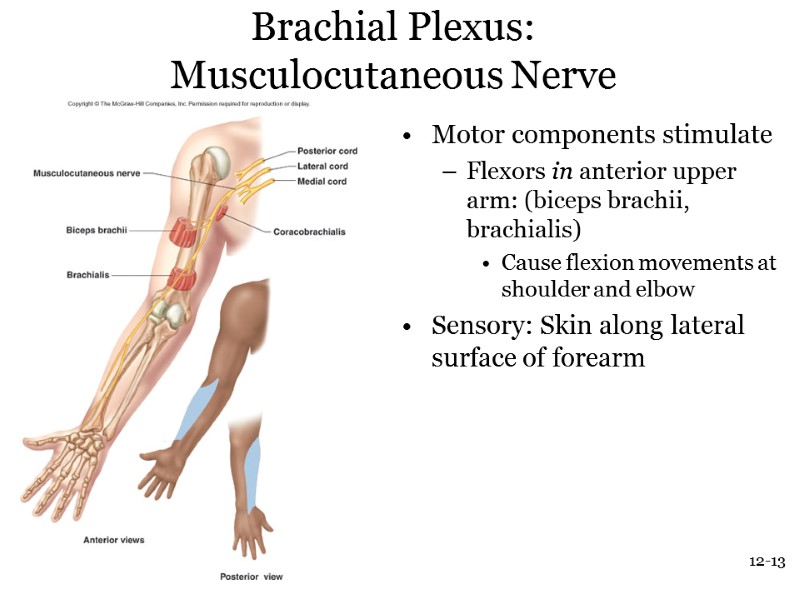
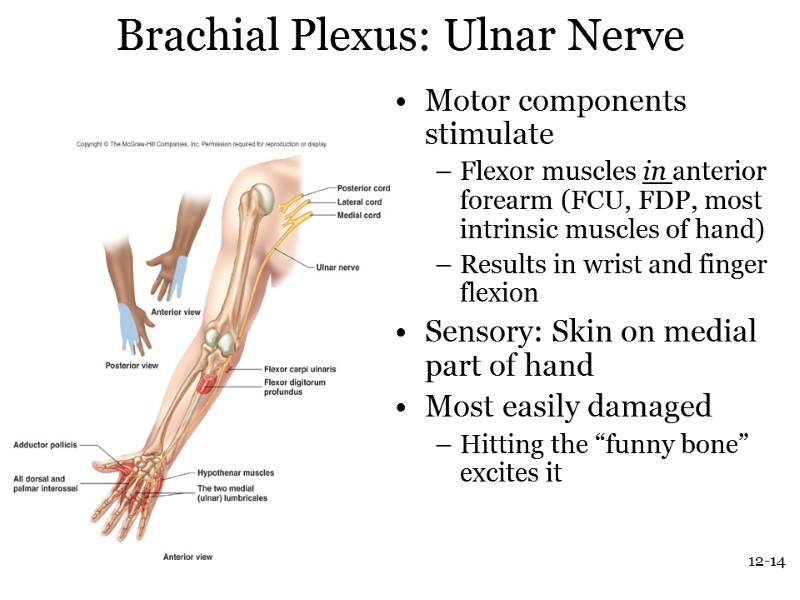
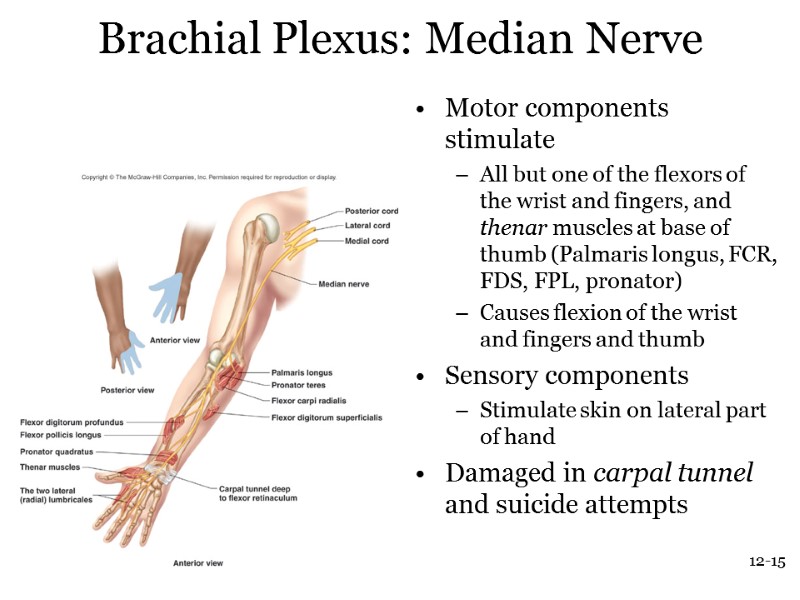
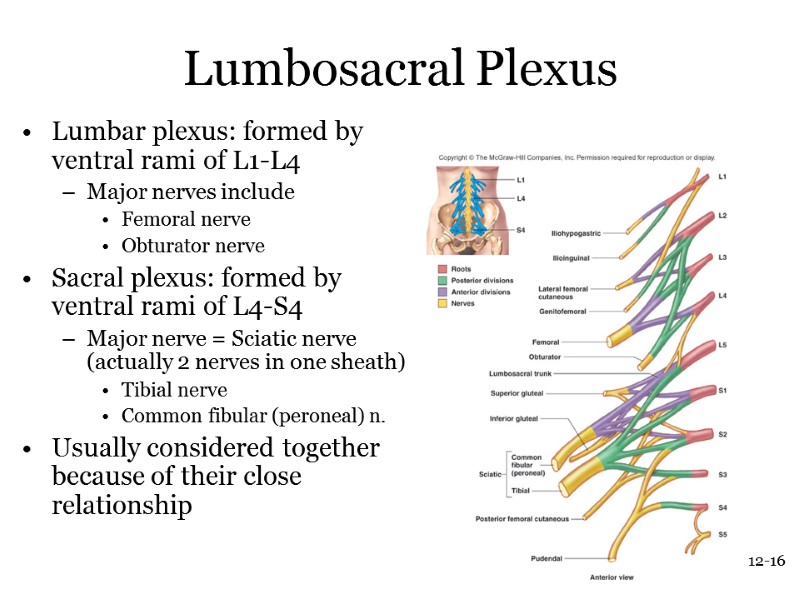
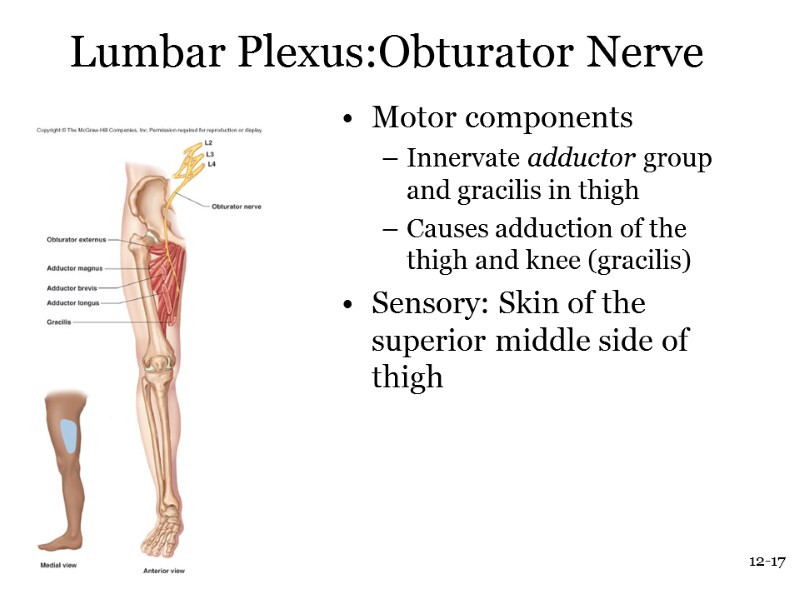
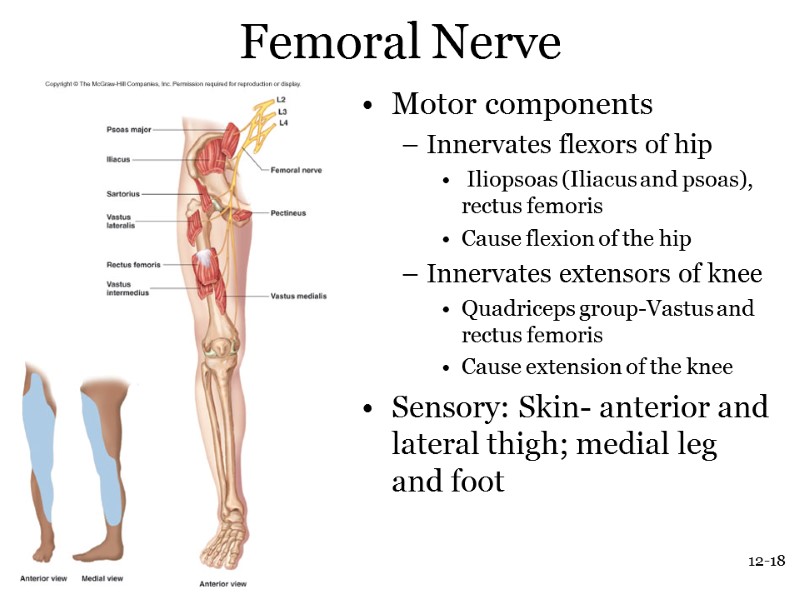
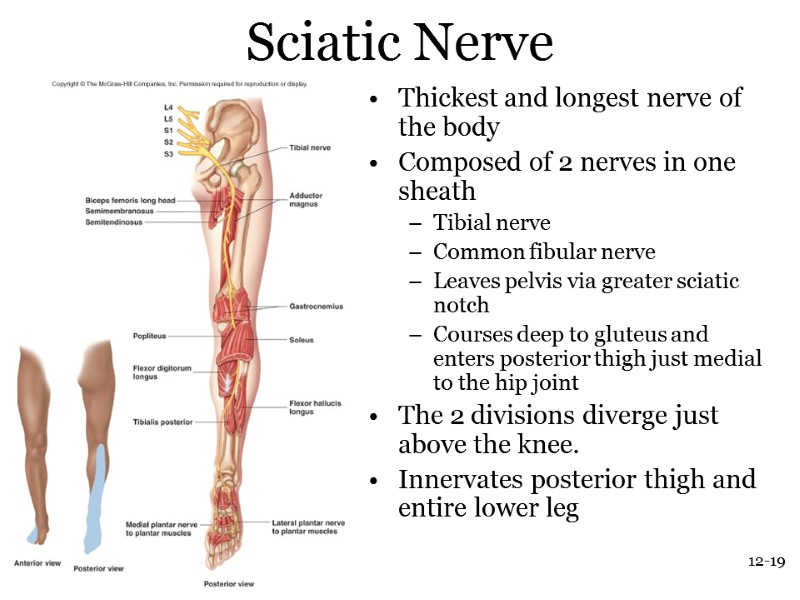
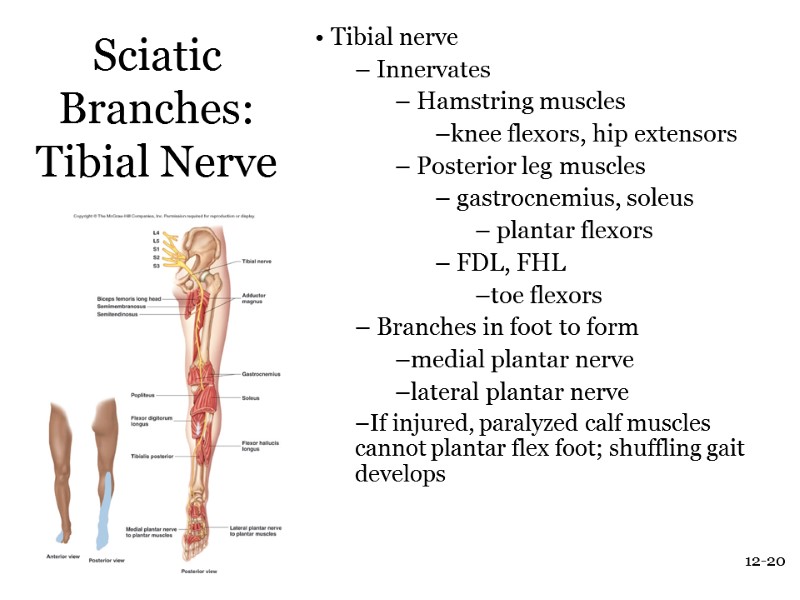
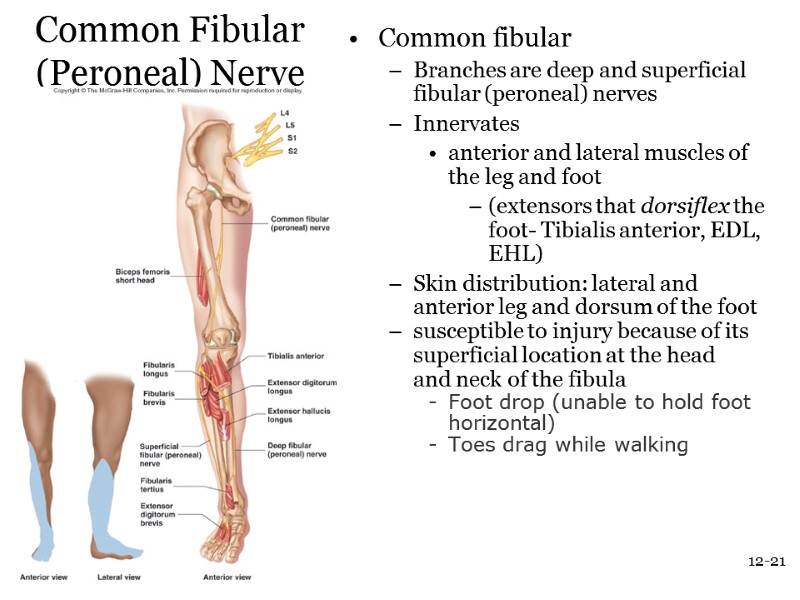
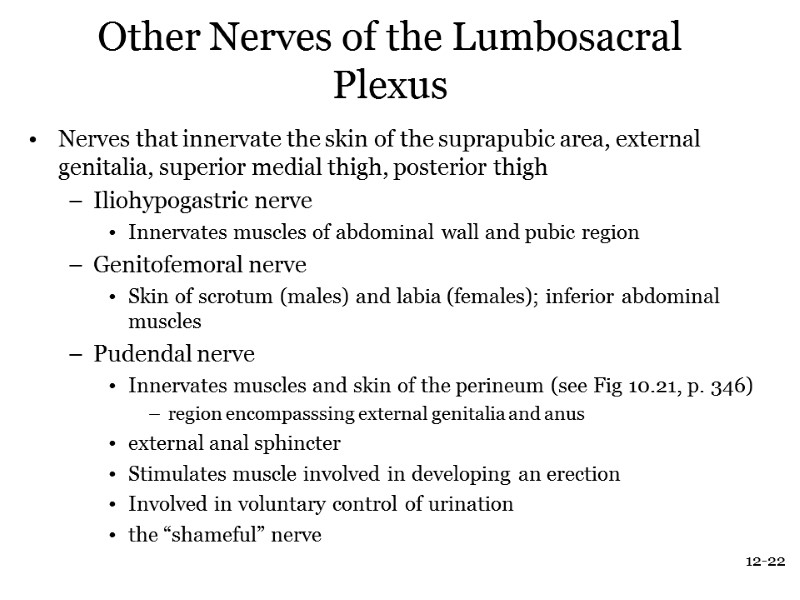
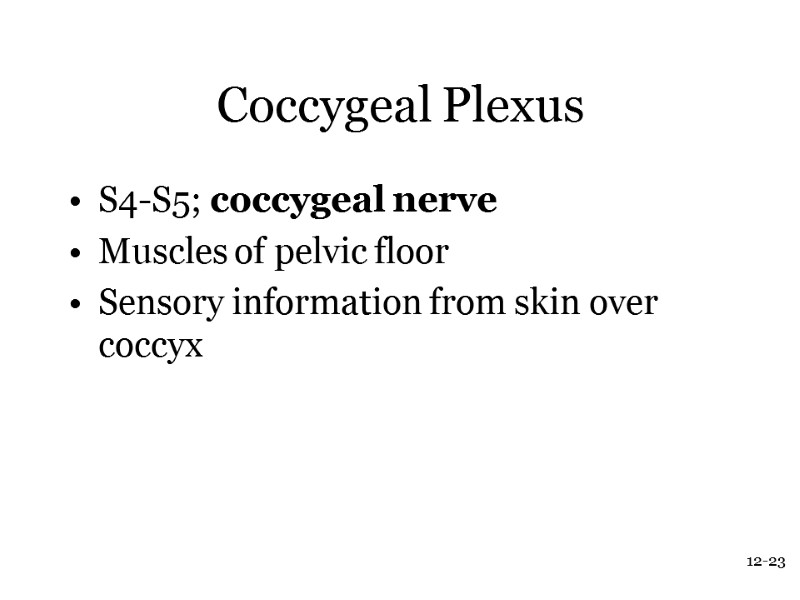
6794-150_spinal_nerves.ppt
- Количество слайдов: 23
 12-1 Spinal Nerves AP 150 Chapter 12
12-1 Spinal Nerves AP 150 Chapter 12
 12-2 Spinal Nerves Spinal nerves attach to the spinal cord via roots Dorsal root Has only sensory neurons Attached to cord via rootlets Dorsal root ganglion Bulge formed by cell bodies of unipolar sensory neurons Ventral root Has only motor neurons No ganglion - all cell bodies of motor neurons found in gray matter of spinal cord
12-2 Spinal Nerves Spinal nerves attach to the spinal cord via roots Dorsal root Has only sensory neurons Attached to cord via rootlets Dorsal root ganglion Bulge formed by cell bodies of unipolar sensory neurons Ventral root Has only motor neurons No ganglion - all cell bodies of motor neurons found in gray matter of spinal cord
 12-3 Spinal Nerves 31 pair each contains thousands of nerve fibers All are mixed nerves have both sensory and motor neurons) Connect to the spinal cord Named for point of issue from the spinal cord 8 pairs of cervical nerves (C1-C8) 12 pairs of thoracic nerves (T1-T12) 5 pairs of lumbar nerves (L1-L5) 5 pairs of sacral nerves (S1-S5) 1 pair of coccygeal nerves (Co1)
12-3 Spinal Nerves 31 pair each contains thousands of nerve fibers All are mixed nerves have both sensory and motor neurons) Connect to the spinal cord Named for point of issue from the spinal cord 8 pairs of cervical nerves (C1-C8) 12 pairs of thoracic nerves (T1-T12) 5 pairs of lumbar nerves (L1-L5) 5 pairs of sacral nerves (S1-S5) 1 pair of coccygeal nerves (Co1)
 12-4 Formation of Rami Rami are lateral branches of a spinal nerve Rami contain both sensory and motor neurons Two major groups Dorsal ramus Neurons innervate the dorsal regions of the body Ventral ramus Larger Neurons innervate the ventral regions of the body Braid together to form plexuses (plexi)
12-4 Formation of Rami Rami are lateral branches of a spinal nerve Rami contain both sensory and motor neurons Two major groups Dorsal ramus Neurons innervate the dorsal regions of the body Ventral ramus Larger Neurons innervate the ventral regions of the body Braid together to form plexuses (plexi)
 12-5 Dermatomal Map Spinal nerves indicated by capital letter and number Dermatomal map: skin area supplied with sensory innervation by spinal nerves
12-5 Dermatomal Map Spinal nerves indicated by capital letter and number Dermatomal map: skin area supplied with sensory innervation by spinal nerves
 12-6 Introduction to Nerve Plexuses Nerve plexus A network of ventral rami Ventral rami (except T2-T12) Branch and join with one another Form nerve plexuses In cervical, brachial, lumbar, and sacral regions No plexus formed in thoracic region of s.c.
12-6 Introduction to Nerve Plexuses Nerve plexus A network of ventral rami Ventral rami (except T2-T12) Branch and join with one another Form nerve plexuses In cervical, brachial, lumbar, and sacral regions No plexus formed in thoracic region of s.c.
 12-7 The Cervical Plexus Buried deep in the neck Under the sternocleidomastoid muscle Formed by ventral rami of first four cervical nerves Most are cutaneous nerves Some innervate muscles of the anterior neck Phrenic nerve – the most important nerve of the cervical plexus
12-7 The Cervical Plexus Buried deep in the neck Under the sternocleidomastoid muscle Formed by ventral rami of first four cervical nerves Most are cutaneous nerves Some innervate muscles of the anterior neck Phrenic nerve – the most important nerve of the cervical plexus
 12-8 Branches of Spinal Nerves Dorsal Ramus Neurons within muscles of trunk and back Ventral Ramus (VR) Braid together to form plexuses Cervical plexus - VR of C1-C4 Brachial plexus - VR of C5-T1 Lumbar plexus - VR of of L1-L4 Sacral plexus - VR of L4-S4 Coccygeal plexus -VR of S4 and S5 Communicating Rami: communicate with sympathetic chain of ganglia Covered in ANS unit
12-8 Branches of Spinal Nerves Dorsal Ramus Neurons within muscles of trunk and back Ventral Ramus (VR) Braid together to form plexuses Cervical plexus - VR of C1-C4 Brachial plexus - VR of C5-T1 Lumbar plexus - VR of of L1-L4 Sacral plexus - VR of L4-S4 Coccygeal plexus -VR of S4 and S5 Communicating Rami: communicate with sympathetic chain of ganglia Covered in ANS unit
 12-9 Cervical Plexus Buried deep in the neck Under the sternocleidomastoid muscle Formed by ventral rami of first four cervical nerves (C1-C4) Most are cutaneous nerves Some innervate muscles of the anterior neck, posterior portion of head Phrenic nerve – the most important nerve of the cervical plexus Phrenic nerve Innervate diaphragm
12-9 Cervical Plexus Buried deep in the neck Under the sternocleidomastoid muscle Formed by ventral rami of first four cervical nerves (C1-C4) Most are cutaneous nerves Some innervate muscles of the anterior neck, posterior portion of head Phrenic nerve – the most important nerve of the cervical plexus Phrenic nerve Innervate diaphragm
 12-10 Brachial Plexus Formed by ventral rami of spinal nerves C5-T1 Five ventral rami form three trunks that separate into six divisions that then form cords that give rise to nerves Major nerves Axillary Radial Musculocutaneous Ulnar Median
12-10 Brachial Plexus Formed by ventral rami of spinal nerves C5-T1 Five ventral rami form three trunks that separate into six divisions that then form cords that give rise to nerves Major nerves Axillary Radial Musculocutaneous Ulnar Median
 12-11 Brachial Plexus: Axillary Nerve Motor neurons stimulate Deltoid, teres minor Abducts arm- deltoid Laterally rotate arm-teres minor Sensory neurons Skin: inferior lateral shoulder
12-11 Brachial Plexus: Axillary Nerve Motor neurons stimulate Deltoid, teres minor Abducts arm- deltoid Laterally rotate arm-teres minor Sensory neurons Skin: inferior lateral shoulder
 12-12 Brachial Plexus: Radial Nerve Motor components stimulate Posterior muscles of arm, forearm, and hand Triceps, supinator, brachioradialis, ECR, ECU, extensor digitorum Cause extension movements at elbow and wrist, thumb movements Sensory components Skin on posterior surface of arm and forearm, hand Damage due to compression results in crutch paralysis Major symptom is ‘wrist drop’ Failure of extensors of wrist and fingers to function Elbow, wrist, and fingers constantly flexed
12-12 Brachial Plexus: Radial Nerve Motor components stimulate Posterior muscles of arm, forearm, and hand Triceps, supinator, brachioradialis, ECR, ECU, extensor digitorum Cause extension movements at elbow and wrist, thumb movements Sensory components Skin on posterior surface of arm and forearm, hand Damage due to compression results in crutch paralysis Major symptom is ‘wrist drop’ Failure of extensors of wrist and fingers to function Elbow, wrist, and fingers constantly flexed
 12-13 Brachial Plexus: Musculocutaneous Nerve Motor components stimulate Flexors in anterior upper arm: (biceps brachii, brachialis) Cause flexion movements at shoulder and elbow Sensory: Skin along lateral surface of forearm
12-13 Brachial Plexus: Musculocutaneous Nerve Motor components stimulate Flexors in anterior upper arm: (biceps brachii, brachialis) Cause flexion movements at shoulder and elbow Sensory: Skin along lateral surface of forearm
 12-14 Brachial Plexus: Ulnar Nerve Motor components stimulate Flexor muscles in anterior forearm (FCU, FDP, most intrinsic muscles of hand) Results in wrist and finger flexion Sensory: Skin on medial part of hand Most easily damaged Hitting the “funny bone” excites it
12-14 Brachial Plexus: Ulnar Nerve Motor components stimulate Flexor muscles in anterior forearm (FCU, FDP, most intrinsic muscles of hand) Results in wrist and finger flexion Sensory: Skin on medial part of hand Most easily damaged Hitting the “funny bone” excites it
 12-15 Brachial Plexus: Median Nerve Motor components stimulate All but one of the flexors of the wrist and fingers, and thenar muscles at base of thumb (Palmaris longus, FCR, FDS, FPL, pronator) Causes flexion of the wrist and fingers and thumb Sensory components Stimulate skin on lateral part of hand Damaged in carpal tunnel and suicide attempts
12-15 Brachial Plexus: Median Nerve Motor components stimulate All but one of the flexors of the wrist and fingers, and thenar muscles at base of thumb (Palmaris longus, FCR, FDS, FPL, pronator) Causes flexion of the wrist and fingers and thumb Sensory components Stimulate skin on lateral part of hand Damaged in carpal tunnel and suicide attempts
 12-16 Lumbosacral Plexus Lumbar plexus: formed by ventral rami of L1-L4 Major nerves include Femoral nerve Obturator nerve Sacral plexus: formed by ventral rami of L4-S4 Major nerve = Sciatic nerve (actually 2 nerves in one sheath) Tibial nerve Common fibular (peroneal) n. Usually considered together because of their close relationship
12-16 Lumbosacral Plexus Lumbar plexus: formed by ventral rami of L1-L4 Major nerves include Femoral nerve Obturator nerve Sacral plexus: formed by ventral rami of L4-S4 Major nerve = Sciatic nerve (actually 2 nerves in one sheath) Tibial nerve Common fibular (peroneal) n. Usually considered together because of their close relationship
 12-17 Lumbar Plexus:Obturator Nerve Motor components Innervate adductor group and gracilis in thigh Causes adduction of the thigh and knee (gracilis) Sensory: Skin of the superior middle side of thigh
12-17 Lumbar Plexus:Obturator Nerve Motor components Innervate adductor group and gracilis in thigh Causes adduction of the thigh and knee (gracilis) Sensory: Skin of the superior middle side of thigh
 12-18 Femoral Nerve Motor components Innervates flexors of hip Iliopsoas (Iliacus and psoas), rectus femoris Cause flexion of the hip Innervates extensors of knee Quadriceps group-Vastus and rectus femoris Cause extension of the knee Sensory: Skin- anterior and lateral thigh; medial leg and foot
12-18 Femoral Nerve Motor components Innervates flexors of hip Iliopsoas (Iliacus and psoas), rectus femoris Cause flexion of the hip Innervates extensors of knee Quadriceps group-Vastus and rectus femoris Cause extension of the knee Sensory: Skin- anterior and lateral thigh; medial leg and foot
 12-19 Sciatic Nerve Thickest and longest nerve of the body Composed of 2 nerves in one sheath Tibial nerve Common fibular nerve Leaves pelvis via greater sciatic notch Courses deep to gluteus and enters posterior thigh just medial to the hip joint The 2 divisions diverge just above the knee. Innervates posterior thigh and entire lower leg
12-19 Sciatic Nerve Thickest and longest nerve of the body Composed of 2 nerves in one sheath Tibial nerve Common fibular nerve Leaves pelvis via greater sciatic notch Courses deep to gluteus and enters posterior thigh just medial to the hip joint The 2 divisions diverge just above the knee. Innervates posterior thigh and entire lower leg
 12-20 Sciatic Branches: Tibial Nerve Tibial nerve Innervates Hamstring muscles knee flexors, hip extensors Posterior leg muscles gastrocnemius, soleus plantar flexors FDL, FHL toe flexors Branches in foot to form medial plantar nerve lateral plantar nerve If injured, paralyzed calf muscles cannot plantar flex foot; shuffling gait develops
12-20 Sciatic Branches: Tibial Nerve Tibial nerve Innervates Hamstring muscles knee flexors, hip extensors Posterior leg muscles gastrocnemius, soleus plantar flexors FDL, FHL toe flexors Branches in foot to form medial plantar nerve lateral plantar nerve If injured, paralyzed calf muscles cannot plantar flex foot; shuffling gait develops
 12-21 Common Fibular (Peroneal) Nerve Common fibular Branches are deep and superficial fibular (peroneal) nerves Innervates anterior and lateral muscles of the leg and foot (extensors that dorsiflex the foot- Tibialis anterior, EDL, EHL) Skin distribution: lateral and anterior leg and dorsum of the foot susceptible to injury because of its superficial location at the head and neck of the fibula Foot drop (unable to hold foot horizontal) Toes drag while walking
12-21 Common Fibular (Peroneal) Nerve Common fibular Branches are deep and superficial fibular (peroneal) nerves Innervates anterior and lateral muscles of the leg and foot (extensors that dorsiflex the foot- Tibialis anterior, EDL, EHL) Skin distribution: lateral and anterior leg and dorsum of the foot susceptible to injury because of its superficial location at the head and neck of the fibula Foot drop (unable to hold foot horizontal) Toes drag while walking
 12-22 Other Nerves of the Lumbosacral Plexus Nerves that innervate the skin of the suprapubic area, external genitalia, superior medial thigh, posterior thigh Iliohypogastric nerve Innervates muscles of abdominal wall and pubic region Genitofemoral nerve Skin of scrotum (males) and labia (females); inferior abdominal muscles Pudendal nerve Innervates muscles and skin of the perineum (see Fig 10.21, p. 346) region encompasssing external genitalia and anus external anal sphincter Stimulates muscle involved in developing an erection Involved in voluntary control of urination the “shameful” nerve
12-22 Other Nerves of the Lumbosacral Plexus Nerves that innervate the skin of the suprapubic area, external genitalia, superior medial thigh, posterior thigh Iliohypogastric nerve Innervates muscles of abdominal wall and pubic region Genitofemoral nerve Skin of scrotum (males) and labia (females); inferior abdominal muscles Pudendal nerve Innervates muscles and skin of the perineum (see Fig 10.21, p. 346) region encompasssing external genitalia and anus external anal sphincter Stimulates muscle involved in developing an erection Involved in voluntary control of urination the “shameful” nerve
 12-23 Coccygeal Plexus S4-S5; coccygeal nerve Muscles of pelvic floor Sensory information from skin over coccyx
12-23 Coccygeal Plexus S4-S5; coccygeal nerve Muscles of pelvic floor Sensory information from skin over coccyx

